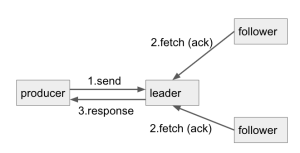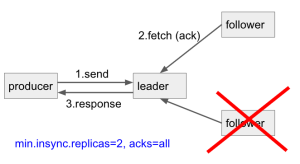Status
Current state: "Under Discussion"
Discussion thread:
JIRA:
Please keep the discussion on the mailing list rather than commenting on the wiki (wiki discussions get unwieldy fast).
Motivation
In Kafka, Producers have the option of either waiting for the message to be committed or not, depending on their preference for tradeoff between latency and durability. This preference is controlled by the acks setting that the producer uses.
Currently, the acks config accepts these values:
acks=0- If set to zero then the producer will not wait for any acknowledgment from the server at all.
acks=1- This will mean the leader will write the record to its local log but will respond without awaiting full acknowledgement from all followers.
acks=all- This means the leader will wait for the full set of in-sync replicas to acknowledge the record.
For acks=all case, the simple flow is like this:
It looks perfect. But there's a caveat here. Like the doc said, acks=all will "wait for the full set of in-sync replicas to acknowledge the record", so what if in-sync replicas only have 1? It will have the same effect as acks=1.
To get the expected durability, users also need to set min.insync.replicas config correctly. In the doc of min.insync.replicas config:
When min.insync.replicas and acks used together, it allows you to enforce greater durability guarantees. A typical scenario would be to create a topic with a replication factor of 3, set min.insync.replicas to 2, and produce with acks of "all". This will ensure that the producer raises an exception if a majority of replicas do not receive a write.
In the most popular scenario: replication factor = 3, min.insync.replicas=2, acks=all, we ensure at least 2 replicas acks, which means, we can tolerate 1 replica out-of-sync or down (ex: rolling update) and still make the write process successfully. This keeps high availability and durability in Kafka.
Let's step back and think again. In the case of replication factor = 3 and all 3 replicas are in-sync replica, if we can achieve high durability with 2 replicas ack, then, could we increase write throughput by just need 2 replicas ack, not 3 of them?
This is what we have now for acks=all , we need to wait for the slowest follower acks (i.e. 500ms) before we can respond to the producer.
I'd like to propose a new config: acks=min.insync.replicas , we just need to wait for the fastest follower acks (i.e. 100ms) then respond to the producer.
Public Interfaces
Briefly list any new interfaces that will be introduced as part of this proposal or any existing interfaces that will be removed or changed. The purpose of this section is to concisely call out the public contract that will come along with this feature.
A public interface is any change to the following:
Binary log format
The network protocol and api behavior
Any class in the public packages under clientsConfiguration, especially client configuration
org/apache/kafka/common/serialization
org/apache/kafka/common
org/apache/kafka/common/errors
org/apache/kafka/clients/producer
org/apache/kafka/clients/consumer (eventually, once stable)
Monitoring
Command line tools and arguments
- Anything else that will likely break existing users in some way when they upgrade
Proposed Changes
Describe the new thing you want to do in appropriate detail. This may be fairly extensive and have large subsections of its own. Or it may be a few sentences. Use judgement based on the scope of the change.
Compatibility, Deprecation, and Migration Plan
- What impact (if any) will there be on existing users?
- If we are changing behavior how will we phase out the older behavior?
- If we need special migration tools, describe them here.
- When will we remove the existing behavior?
Test Plan
Describe in few sentences how the KIP will be tested. We are mostly interested in system tests (since unit-tests are specific to implementation details). How will we know that the implementation works as expected? How will we know nothing broke?
Rejected Alternatives
If there are alternative ways of accomplishing the same thing, what were they? The purpose of this section is to motivate why the design is the way it is and not some other way.



